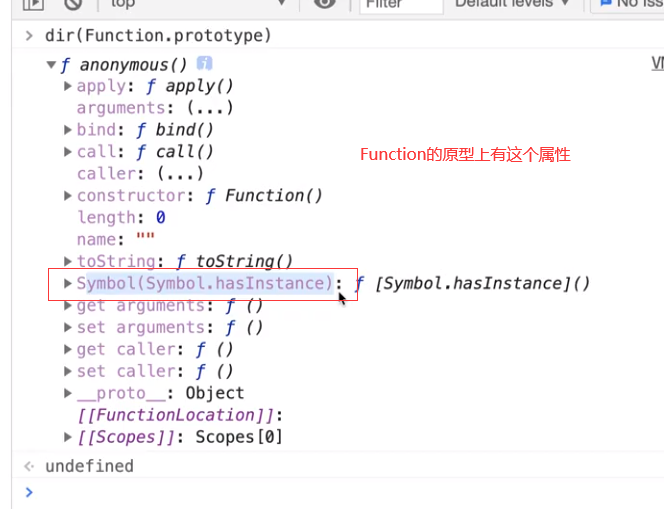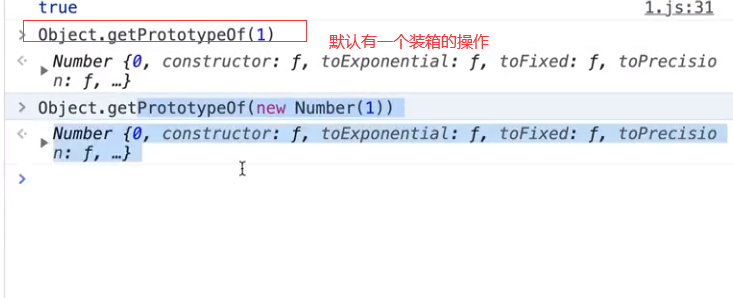typeof&instanceof
一:typeof
- 1.定义: typeof用来检测数据类型的运算符
- 2.语法: typeof [value] => 字符串,包含对应的数据类型
3.返回值
typeof检测的结果首先是一个字符串;- 字符串中包含了对应的数据类型(例如: “number”、”string”、”boolean”、”undefined”、”object”、”function”、”symbol”、”bigint”)
- 多个typeof检测 typeof typeof typeof [12,20,30]=>’string’👇
由于
typeof返回的结果永远是一个字符串(字符串中包含了对应的类型),所以连续出现两个及两个以上typeof检测的时候,最后结果都是"string"
4. 局限性:不能细分对象
- typeof 检测对象类型值,除了可执行对象{函数}可以检测出来是“function”,其余都是“object”
- 基于typeof检测一个未被声明的变量,结果是“undefined”,而不会报错「基于let在后面声明则会报错」
- typeof 检测原始值对应的对象类型的值,结果是“object”typeof new Number(1)
- typeof null -> “object”
- 为啥: typeof检测数据类型是,按照计算机底层存储的二进制值,来进行检测的,它认为以“000”开始的都是对象,而null全是零,所以被识别为对象,但是他不是对象 是基本数据类型值
- 5. 好处: 简单、性能好
二:instanceof
- 1.定义:临时用来“拉壮丁”检测数据类型,本意是检测当前实例是否属于这个类
- 2.语法:[value] instanceof [Ctor] => true/false
- 3.属于返回true,不属于返回falase1)
- 4.好处:细分对象数据类型值 例如:想检测这个值是否为数组,只需要看他是否为Array类的实例即可
- 「但是不能因为结果是TRUE,就说他是标准普通对象」
- 5.弊端:
- 不能检测原始值类型的值「但是原始值对应的对象格式实例则可以检测」;
- 但是因为原型链指向是可以肆意改动的,所以最后检测的结果不一定准确;
let arr = [10, 20, 30];console.log(arr instanceof Array); //=>trueconsole.log(arr instanceof RegExp); //=>falseconsole.log(arr instanceof Object); //=>true 不管是数组对象还是正则对象,都是Object的实例,检测结果都是TRUE,所以无法基于这个结果判断是否为标准普通对象console.log(new Number(1) instanceof Number); //=>trueconsole.log(1 instanceof Number); //=>false 可以看出不能检测原始值类型
底层原理方式
按照原型链检测的 只要当前检测的构造函数(它的原型对象),出现在实例的原型链上,则检测结果就是TRUE; 如果找到Object.prototype都没有找到,则结果是FALSE;
//不靠谱操作更改原型
function Fn(){
}
Fn.prototype=Array.prototype;//把函数的原型更改为数组的原型
let f=new Fn;
console.log(f instanceof Array); //=>true
底层原理处理
f instanceof Fn -> FnSymbol.hasInstance Function.prototype[Symbol.hasInstance]=function… 所有的函数都是Function这个类的实例 所有的函数都拥有这个属性

普通写法的构造函数 它的Symbol.hasInstance属性无法被直接修改的 但是ES6语法中可以!!
- 我们知道这种机制,可以通过重写的方式改变默认的结果 ,把它变成自己想要的结果
//普通写法的构造函数==================
//function Fn() { };
//Fn[Symbol.hasInstance]=function(){};
//控制台输出Fn[Symbol.hasInstance]=>ƒ [Symbol.hasInstance]() { [native code] }
//let f = new Fn;
//console.log(f instanceof Fn);//=>true
//console.log(Fn[Symbol.hasInstance](f));//=>true
//ES6写法=================================================================
class Fn {
static [Symbol.hasInstance](obj) {
console.log('OK');
if (Array.isArray(obj)) return true;
return false;
}
};
let f=new Fn();
let arr = [10, 20, 30];
console.log(f instanceof Fn);//=>false
console.log(arr instanceof Fn); //=>true
自己重写instanceof
我们这个方法支持原始值类型 instanceof 右侧必须是个对象 还是个函数对象 而且必须得有prototype
//obj 检测的实例 Ctor构造函数
const instance_of = function instance_of(obj, Ctor) {
if (Ctor == null) throw new TypeError('Right-hand side of instanceof is not an object');
let type = typeof Ctor;
//=>不是object和function
if (!/^(object|function)$/i.test(type)) throw new TypeError('Right-hand side of instanceof is not an object');
//=>不是函数
if (!/^function$/i.test(type)) throw new TypeError('Right-hand side of instanceof is not callable');
//=>验证有没有prototype 例如箭头函数没有prototype
if (!Ctor.prototype) throw new TypeError('Function has non-object prototype in instanceof check');
let proto = Object.getPrototypeOf(obj);//=>获取它的原型对象
while (proto) {
//在查找过程汇总 如果我当前找到的原型对象出现在了构造函数的原型对象
if (proto === Ctor.prototype) return true;
proto = Object.getPrototypeOf(proto);//=>一直找 找不到为止
}
return false;
};
//传实例和构造函数
console.log(instance_of([], Array)); //=>true
console.log(instance_of([], RegExp)); //=>false
console.log(instance_of(1, Number)); //=>true
console.log(instance_of(Symbol(), Symbol)); //=>true
console.log(instance_of([],{})); //报错
三:constructor
能弥补instanceof的不足 找到谁就以谁为主 constructor的修改比instanceof更“肆无忌惮”
- 1、定义:判断当前的实例的constructor的属性值是不是预估的类(利用他的实例数据类型检测)
- 2、语法:实例.constructor === 类
- 3、返回值:属于返回TRUE,不属于返回FALSE
- 4、优点:
- 实例.constructor 一般都等于
类.prototype.constructor也就是当前类本身(前提是你的 constructor 并没有被破坏) - 能检测基本数据类型
- 实例.constructor 一般都等于
- 5、局限性:
- 1)不能够给当前类的原型进行重定向,会造成检测的结果不准确
```javascript function Fn(){let arr=[], n=10, m=new Number(10); console.log(arr.constructor===Array);//=>true console.log(arr.constructor===RegExp);//=>false //如果CTOR结果和Object相等,说明当前可能是标准普通对象 console.log(arr.constructor===Object);//=>false console.log(n.constructor===Number);//=>true console.log(m.constructor===Number);//=>true
- 1)不能够给当前类的原型进行重定向,会造成检测的结果不准确
}; let f=new Fn;
//=>更改重定向前 // console.log(f.constructor===Fn);//=>true // console.log(f.constructor===Object);//=>false
Fn.prototype={}; //更改重定向后 就没有了constructor console.log(f.constructor===Fn);//=>false console.log(f.constructor===Object);//=>true
<a name="ahc0i"></a>
# 四:Object.prototype.toString.call()
- 优点:这是JS中唯一一个检测数据类型没有任何瑕疵的「最准确的,除了性能比typeof略微少那么一丢丢,写起来略微麻烦那么一丢丢」
- 语法:
- Object.prototype.toString([value]);
- ({}).toString.call(被检测的实例)
- 返回值:是一个字符串"[object当前被检测实例所属的类]"
- [object Number/String/Boolen/Null/Undefined/Symbol/BigInt/Object/Function/Array/RegExp/Date/Math/Error...]"
- 大部分内置类的原型上都有toString方法,一般都是转换为字符串的,
- 如:Array.prototypeNumber.prototype/Boolean.prototype/Function.prototype ...
- 除了 Object.prototype.toString是检测数据类型的,返回值中包含自己所属的构造函数信息...
```javascript
//通过这一点就比typeof强
Object.prototype.toString.call(1);//=>"[object Number]"
Object.prototype.toString.call(new Number);//=>"[object Number]"
Object.prototype.toString.call(1);//"[object Number]"
Object.prototype.toString.call('');//"[object String]"
Object.prototype.toString.call(true);//"[object Boolean]"
Object.prototype.toString.call(null);//"[object Null]"
Object.prototype.toString.call(undefined);//"[object Undefined]"
Object.prototype.toString.call(Symbol());//"[object Symbol]"
Object.prototype.toString.call(12n);//"[object BigInt]"
Object.prototype.toString.call(/\d+/);//"[object RegExp]"
Object.prototype.toString.call([]);//"[object Array]"
Object.prototype.toString.call(()=>{});//"[object Function]"
Object.prototype.toString.call({});//"[object Object]"
Object.prototype.toString.call(Math);//"[object Math]"
Object.prototype.toString.call(function*(){});//"[object GeneratorFunction]"
原理:
1.为啥要用call?
- ([]).toString() 调用的是Array.prototype上的toString,是转换为字符串
- ({}).toString() 调用的是Object.prototype上的toString,是检测数据类型的「方法中的this是谁,就是检测谁的类型」
- Object.prototype.toString.call([value]) 我们需要把Object.prototype.toString执行,基于call方法 改变其中的this
- ({}).toString.call(10)=>”[object Object]”
2.检测返回值遵循啥规则?
- 一般都是返回当前实例所属的构造函数信息
- 但是如果实例对象拥有 Symbol.toStringTag 属性,属性值是啥,最后返回的就是啥,例如:Math[Symbol.toStringTag]=”Math” => Object.prototype.toString.call(Math) “[object Math]”
//class Fn {}; //let f=new Fn; //console.log(Object.prototype.toString.call(f));//[object Object] //======>怎么样让结果等于[object Fn] 以下例子 class Fn { // constructor() { // this[Symbol.toStringTag] = 'Fn'; // } [Symbol.toStringTag] = 'Fn'; } let f = new Fn; // console.log(Object.prototype.toString.call(Fn)); //“[object Function]” console.log(Object.prototype.toString.call(f)); //“[object Fn]”


